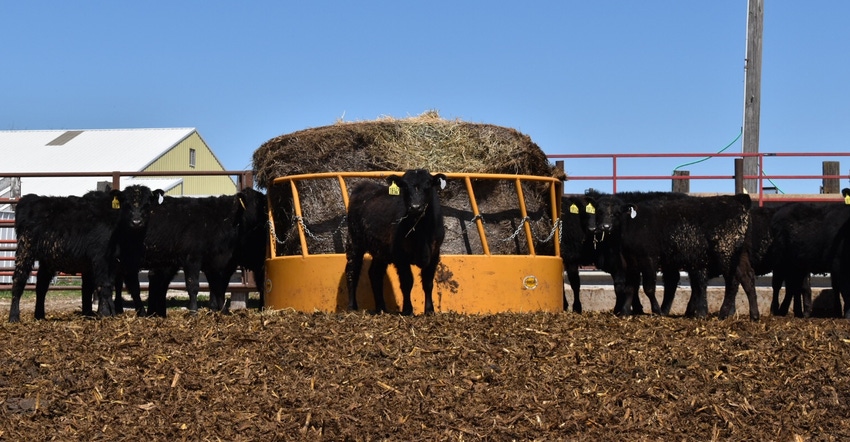December 4, 2020

Drought and other weather events in 2020 have caused a tight forage supply going into the winter-feeding period for many beef cattle operations. Hay is high priced if you are buying it. Here are some tips to make the most of the forage resource you’re feeding this winter. They are provided by Iowa State University Extension beef specialists Erika Lundy, Beth Reynolds and Denise Schwab.
1. Calculate feed needs and compare to inventory. A basic calculation assumes intake to be 2.25% to 2.5% of body weight. Knowing this, a quick calculation for feeding 100 mature cows for five months would be: 100 cows × 1,300 lbs. × 2.5% = 3,250 lbs. dry matter per day × 150 days = 487,500 lbs., or 244 tons.
Next, account for the forage dry matter. If you assume the hay is 85% dry matter, 287 tons of hay is needed. Feed waste should also be accounted for, with 10% to 15% expected to be wasted in good feeding programs. That means 330 tons of hay are needed to feed 100 mature cows for five months. Don’t forget to account for bulls, heifers, weaned calves or other livestock when calculating feed needs and comparing feed inventory.
2. Reduce nutrient requirement and feed intake. Some of the more obvious strategies to reduce feed needs include weaning fall calves early and following through on marketing cows that you held off on selling until a new tax year. Also, consider environmental factors that impact feed needs, and take action to reduce spikes in nutrient requirements. Two examples are providing windbreaks to combat cold stress and controlling mud. Research shows that 4 to 8 inches of mud reduces feed intake by 15% and increases requirements.
3. Look for ways to minimize feed waste. Bale storage methods and bale feeders have been studied extensively to compare feed waste. Bales should be smaller in diameter than the feeder. By feeding smaller-diameter hay, more hay will fall into the bottom of the feeder rather than on the ground as cows pull out and consume the hay. Although associated with a high capital cost, improving storage or feeding methods doesn’t take long for hay savings to pay for the investment.
4. Limit access to hay. Research has shown that a cow consumes her intake of dry forage within six hours. Because of this, restricting time to hay access can reduce intake and waste by approximately 20%. This setup requires knowing the hay feed value to ensure nutritional requirements are met. If not met, a supplement is needed. Adequate feeder and bunk space are critical. The same concept applies when limit-feeding hay in the field by ensuring cows have the hay cleaned up within six hours of feeding with minimal waste.
5. Consider a supplement. While supplementation often is already needed by late gestation because hay quality is insufficient to meet nutrient requirements, supplements can also be used to reduce hay intake and stretch the hay supply. While feeding a supplement should reduce forage intake, remember that feeding a pound of supplement will not result in a pound of forage replaced. If feeding a supplement, be sure to include an ionophore. Ionophores can improve feed efficiency up to 10% by lowering the maintenance requirement of rumen microbes, therefore, lowering feed intake.
Even though stretching the current hay supply is possible, additional forage reserves may still need to be purchased. Evaluate what types of feedstuffs you can source and realistically feed. Then compare the cost of those supplements on a unit of protein or energy basis to hay for sale in your area to determine what’s the better buy for your operation’s needs.
For many cattle producers, purchasing low-quality hay and supplementing it to meet requirements will be the best approach. For others, the investment in higher-quality, more expensive hay might be necessary in order to provide adequate nutrition to the cow herd.
Source: ISU, which is solely responsible for the information provided and is wholly owned by the source. Informa Business Media and all its subsidiaries are not responsible for any content contained in this information asset.
You May Also Like




